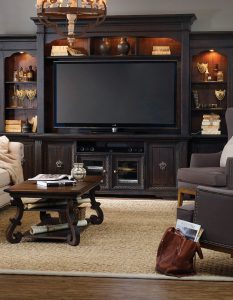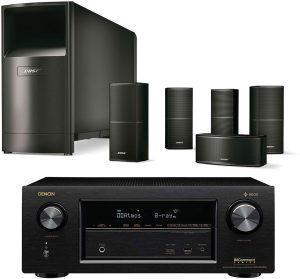 Gone are the days when a spare bedroom and copious amounts of cash were the only way to bring the theater experience into the home. This is the age of functionality and efficiency where a living room is prime real estate for all of your cinema needs. Whether you decide to revamp your entire living room or integrate parts of your current arrangement, the following guidelines will help you create the home theater you always dreamed of.
Gone are the days when a spare bedroom and copious amounts of cash were the only way to bring the theater experience into the home. This is the age of functionality and efficiency where a living room is prime real estate for all of your cinema needs. Whether you decide to revamp your entire living room or integrate parts of your current arrangement, the following guidelines will help you create the home theater you always dreamed of.
Finding the Right TV
To begin, know the lighting of the room you will be transforming. There are different types of TVs suggested based on the type of lighting a room sports. If your room is dark or uses dim lighting, go with plasma or an OLED screen type. These screens are known for their deep blacks and saturated color pallets. For a brightly lit room, consider an LED or LCD screen and for normal lighting conditions, LED or OLED. These TV types have been around for years and typically bring a nice, even color palette in their display.
Next, you need to know the two most important aspects of TV shopping – size and picture quality. For size, know that TVs fall into varying “classifications”. Thirty-three to forty-nine inch televisions are versatile for average sized spaces. The fifty to sixty-four inch classification will fill out any space in your home for a premium viewing experience. The final and largest classification is the sixty-five to ninety inch class. This classification is intended for rooms that are solely for immersive viewing intent; with one of these you’ll have more TV than wall. In order to determine the perfect size for a TV, take measurements of the room and the distance between where the TV will be placed and the couches. While most assume that a bigger TV is better, there is the inherent risk that the TV will be too big and overwhelm the area.
As for picture quality, this is a result of a television’s resolution, which became an important specification around the year 2006 when HD became an in-home standard. Resolution may seem like an abstract term when you hear it in commercials, but it is really quite simple. A TV’s resolution is the amount of pixels that the TV system can display on the screen at any time. The higher a screen’s resolution, the more pixels the system can display; thus, the more detailed an image will be on the screen. We will focus on the HD resolution category because it’s 2018 and there’s no point in thinking about anything under, unless you’re building a museum exhibit. The three main HD resolution categories are 720p, 1080p and 2160p. The standard HD set is 720p; these televisions provide a quality HD picture for DVD’s and TV shows at very affordable prices. The next step is 1080p; often called “full HD,” these sets allow you to watch Blu-ray movies, full HD content on pay per view and all TV programming. They are the most common HDTV resolution available but will cost slightly more than 720p. Currently, the highest tier category and most impressive resolution is 2160p. Some companies will call them 4k, UHD or 4k Ultra HD, but all you need to know is 2160p offers the best resolution in the market place. These sets give you four times the resolution 1080p offers and are, bar none, the go to for someone looking for a truly immersive experience.
Above all, do not let a sales person talk you into a purchase based solely on its features. These features will come with an extra cost, so keep in mind the budget and boundaries you have set for yourself. It might be able to connect to the internet, but if it can’t suck you into a movie and leave you wanting more, it’s pointless. In addition to sales tactics, you may hear jargon of “refresh rate”. This is the rate in which each frame is rendered to display. Refresh rates range from 60Hz, 120Hz and even 240Hz. Although, 120Hz is a great view on any television. On an LCD display, 60Hz may often appear blurry or distorted, so aim for the 120Hz in most cases.
Decent Surround Sound Is Key
 Nothing produces a theater-like vibe like the deep bass of a subwoofer and the enclosing feeling of surround sound. Home audio systems can be very expensive, but it is not impossible to achieve the desired effect at a more conservative price point. The important thing is to understand the different components of an audio system and determine which type fits your budget and layout. The cheapest and easiest form of home audio is installing a sound bar to sit right below your TV. While the sound bar is a great starting place and an upgrade from a TV’s built-in speakers, this single, slender speaker does not pack the kind of punch that one is expecting of a home theater. In order to get a genuine home theater experience, a 5.1 sound system is recommended. A 5.1 system includes five speakers and one subwoofer, which emits a lower frequency to capture the deeper bass sounds. The five speakers are typically arranged around the TV in order to provide depth of sound or in each corner of the room to really create a surround sound experience. The subwoofer is placed on the floor in the corner of a room to achieve maximum reach and fill the entire room with sound. The size of your living room will determine the size of the speakers, but keep in mind your current living room layout and entertainment unit. Most people prefer nondescript speakers that they can hide in their wall units or mount to the upper corners of their living room walls in order to avoid clutter.
Nothing produces a theater-like vibe like the deep bass of a subwoofer and the enclosing feeling of surround sound. Home audio systems can be very expensive, but it is not impossible to achieve the desired effect at a more conservative price point. The important thing is to understand the different components of an audio system and determine which type fits your budget and layout. The cheapest and easiest form of home audio is installing a sound bar to sit right below your TV. While the sound bar is a great starting place and an upgrade from a TV’s built-in speakers, this single, slender speaker does not pack the kind of punch that one is expecting of a home theater. In order to get a genuine home theater experience, a 5.1 sound system is recommended. A 5.1 system includes five speakers and one subwoofer, which emits a lower frequency to capture the deeper bass sounds. The five speakers are typically arranged around the TV in order to provide depth of sound or in each corner of the room to really create a surround sound experience. The subwoofer is placed on the floor in the corner of a room to achieve maximum reach and fill the entire room with sound. The size of your living room will determine the size of the speakers, but keep in mind your current living room layout and entertainment unit. Most people prefer nondescript speakers that they can hide in their wall units or mount to the upper corners of their living room walls in order to avoid clutter.
In addition to speakers, an AV receiver is a necessity. AV receivers enable communication between your new surround sound speakers and your devices to ensure that all the components are working cohesively. AV receivers amplify audio signals to your surround sound speakers, allowing you to switch between video sources, so you can play videogames, watch DVDs, or tune in to cable all while enjoying the same level of high-quality sound. When purchasing an AV receiver, make sure to find one that has more HDMI inputs than you currently need. This gives your system some flexibility in the event that you decide to connect more devices.
It’s More than Just the Tech
 Maybe you’re building this because you finally have the space for that dream TV; perhaps you’re doing it because you’ve got some time and want to change up the way you interact with your space. At the end of the day, what it’s really all about is the way you interact with those around you. Use your expert knowledge to design something you can share with your friends or family.
Maybe you’re building this because you finally have the space for that dream TV; perhaps you’re doing it because you’ve got some time and want to change up the way you interact with your space. At the end of the day, what it’s really all about is the way you interact with those around you. Use your expert knowledge to design something you can share with your friends or family. ![]()
Katerin Rodriguez and Matthew Jones
Home & Yard Magazine




